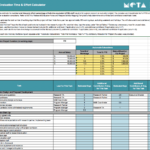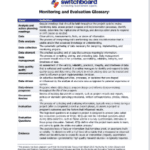Monitoring and evaluation (M&E) is key to strong program design and delivery, both so service providers can track and improve their work and so funders can receive needed reports. But due to capacity issues, financial and time constraints, or the absence of clear processes, there are many reasons why M&E may sometimes be sidelined, infrequently addressed, or completely overlooked.
The best way to approach M&E is to commit to a culture of learning and program improvement as early as possible in the project cycle. In this blog, we share relevant Switchboard learning resources to help you get started with M&E. We hope these resources provide useful strategies for incorporating M&E into your programming and organizational standards!
What is M&E?
M&E are both processes employed to collect and analyze information about a program. However, while monitoring is more commonly an ongoing and systematic process, evaluation typically happens less frequently, often at the end of a program or after a program phase. In addition, monitoring is a process that usually provides answers on program progress, for example: what program activities were completed, and are any short-term program adjustments needed? Evaluation, on the other hand, usually answers questions related to program outcomes, for example: did we see the results we expected, and did our program have an impact?
Together, M&E offer an opportunity to assess efficiency and cost, increase transparency, and measure the impact of the work being done. M&E systems adopted throughout the program cycle produce data-driven conclusions on what works – and thus can be replicated – in program implementation, as well as how services can be improved.
A lot of terminology can be associated with M&E, and vocabulary definitions can vary widely. You can use this glossary to clear up confusion and be sure you understand what is meant by M&E terms used in Switchboard resources.
After completing this 20-minute e-learning module, you will be able to describe logic models and their importance to M&E; define common M&E terms; differentiate between M&E; and describe three types of evaluation.
The Data-Driven, Evidence Based Project Cycle
In designing programs to respond to the needs of refugees and other newcomers, service providers have the opportunity to make program processes more data-driven and evidence-based. Data-driven programs are those where data shapes program design and informs decision-making during the life of the program. Evidence-based programs are those where existing evidence has been used to inform the project’s logic and implementation.
This tip sheet offers seven tips you can use during program planning to help ensure your programs are data-driven and evidence-based.
Evidence-based practices are now easier to find due to more research, open-access publications, evidence summaries, and training. However, service providers may struggle with putting the available evidence into action. This is where implementation science can provide guidance. This guide discusses barriers and facilitators; strategies; theories, models, and frameworks; practice; and equity considerations related to implementation science.
Committing to an M&E Cycle
Making M&E a standard practice across programs requires a commitment to a culture of M&E at the organizational level. This commitment includes adopting M&E procedures throughout the program cycle, consistent reminders of why M&E methods are valuable for program design and implementation, and an expansion of roles to include data-related responsibilities.
- Program M&E: A Path Towards Program Improvement and Better Outcomes for Refugee Clients (Archived Webinar)
This webinar, originally hosted on March 14, 2016, discusses the role that M&E can play in achieving improved outcomes for refugee clients. The webinar provides strategies for changing organizational culture around M&E with practical examples from programs operated by IRC-San Diego.
Creating an organizational culture committed to M&E is a common challenge. This tip sheet gives five action steps you can take to make M&E a priority at your organization, get buy-in from staff and leaders, and ensure that the phrase “monitoring and evaluation” elicits fewer sighs and more enthusiasm at your next team meeting.
Want to learn more? Stay tuned for a forthcoming blog post with resources on project design, including theories of change and logical frameworks (logframes). Other resources on applying M&E practices throughout the program cycle are also available in Switchboard’s Resource Library!










